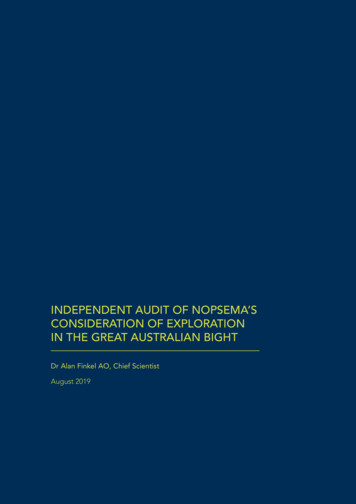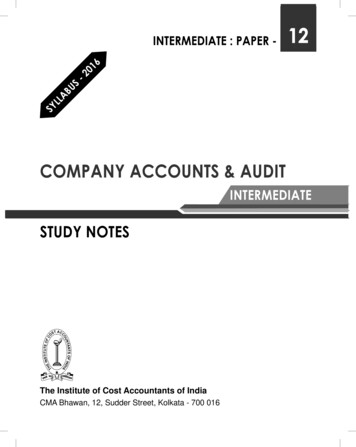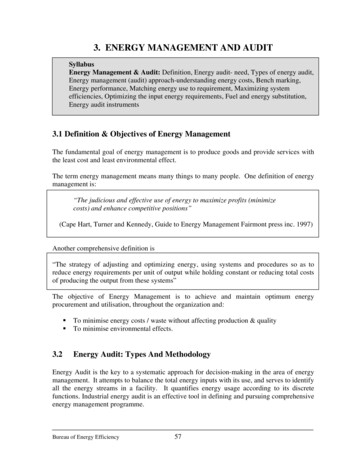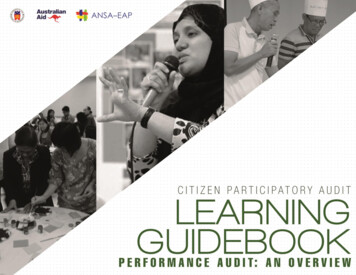
Transcription
INDEPENDENT AUDIT OF NOPSEMA’SCONSIDERATION OF EXPLORATIONIN THE GREAT AUSTRALIAN BIGHTDr Alan Finkel AO, Chief ScientistAugust 2019
Commonwealth of Australia 2019Ownership of intellectual property rightsUnless otherwise noted, copyright (and any other intellectual property rights, if any) in this publication isowned by the Commonwealth of Australia.Creative Commons licenceAttributionCC BY 4.0All material in this publication is licensed under a Creative Commons Attribution 4.0 International Licence,save for content supplied by third parties, logos, any material protected by trademark or otherwise noted inthis publication, and the Commonwealth Coat of Arms. These are forms of property which theCommonwealth cannot or usually would not license others to use.Creative Commons Attribution 4.0 International Licence is a standard form licence agreement that allowsyou to copy, distribute, transmit and adapt this publication provided you attribute the work. A summary ofthe licence terms is available from nt contained herein should be attributed as ‘Independent audit of NOPSEMA’s consideration ofexploration in the Great Australian Bight, Commonwealth of Australia, 2019’.Produced by: Dr Alan Finkel AO, Australia’s Chief ScientistDesigned by: Department of Industry, Innovation and ScienceEdited by: Tim Wallace2Independent Audit of NOPSEMA’s Consideration of Exploration in the Great Australian Bight
PrefaceDear MinistersI am pleased to provide you with my audit of the National Offshore PetroleumSafety and Environmental Management Authority’s (NOPSEMA) considerationof current exploration activity in the Great Australian Bight.The Great Australian Bight is important to local communities, fishing andtourism industries. It is also considered to be highly prospective for petroleumresources and a frontier for exploration. Community concern regardingpetroleum exploration activities in the Great Australian Bight has driven a desirefor assurance in NOPSEMA’s processes and decision-making as the independentregulator for offshore petroleum activities in Commonwealth waters.I have found that the regulator’s processes and guidelines appropriately takeinto account all environmental risks and impacts as required under theregulations. Importantly, through the audit, I have found that NOPSEMA’spractices properly and fully implement its processes and guidelines. In addition,everyone with whom I engaged who had previously interacted with NOPSEMAspoke highly of its professionalism, skilled workforce and determination toensure Australia’s offshore industry is operating properly. Collectively, thesefindings should provide assurance to Australians that NOPSEMA is highlycapable of assessing exploration activity in the Great Australian Bight.Changes in recent months to the regulation of offshore oil and gas activitieshave sought to improve the transparency of NOPSEMA’s assessment anddecision-making process. I have identified some opportunities that mightfurther improve the transparency of NOPSEMA’s operations, and the regime asa whole, and increase confidence in and understanding of the regulator.In developing my findings and opportunities I had the expert assistance ofProfessor Peta Ashworth, Dr Geoffrey O’Brien, Dr David Smith and Mr SteveWalker. Their expert advice in their respective fields made it possible for theaudit to be completed to a high standard in the required timeframes. I wasalso supported by a highly capable taskforce.The stakeholders I met with during consultations engaged in a positive andproductive way, each providing a different perspective. I appreciate the timetaken by all in furthering the discussion of exploration activities in the Bight.Dr Alan Finkel AOAustralia’s Chief ScientistReviewerIndependent Audit of NOPSEMA’s Consideration of Exploration in the Great Australian Bight3
4Independent Audit of NOPSEMA’s Consideration of Exploration in the Great Australian Bight
ContentsAbbreviationsGlossary78Executive summary111. Introduction1.1. Audit process1719Findings and opportunities132. Legislative and governance frameworks2.1. Legislation and regulations2.2. Objective-based regulation2.3. Governance arrangements2.4. Regulating offshore petroleum activities2.5. Environment plan assessment process2.6. Streamlining offshore petroleum approvals2.7. Australian Marine Parks21212223242529303. NOPSEMA processes and practices3.1. Organisational capability of NOPSEMA3.2. Consistency of processes and practices with regulatory requirements3.3. Processes for titleholders to provide additional informationand modify plans3.4. ‘As low as reasonably practicable’ (ALARP) and ‘acceptable’323234414. Stakeholder engagement and consultation4.1. Regulatory requirements4.2. Defining relevant persons4.3. Public comments4.4. Equinor’s Stromlo-1 consultation4.5. Key matters report4545475050535. Scientific and technical information5.1. Internal and external assessment processes5.2. Scientific understanding of the Great Australian Bight5.3. Matters protected under the EPBC Act and Australian MarinePark values5.4. Assessing expected and potential well impacts545455566. Improving the understanding and operation of the regime6.1. Visibility of NOPSEMA6.2. Communicating oil-spill risk6.3. Improving community understanding of the offshore oil and gasregulatory regime65656568Independent Audit of NOPSEMA’s Consideration of Exploration in the Great Australian Bight43595
7. ConclusionAppendix A: Terms of referenceAppendix B: Experts assisting the Chief Scientist697073Appendix D: NOPSEMA guidance and information78Appendix C: Consultation675Independent Audit of NOPSEMA’s Consideration of Exploration in the Great Australian Bight
AbbreviationsALARPAs Low As Reasonably PracticableCEOChief Executive OfficerCSIRO Commonwealth Scientific and Industrial ResearchOrganisationEMBAEnvironment that May Be AffectedEnvironment Regulations Offshore Petroleum and Greenhouse Gas Storage(Environment) Regulations 2009EPBC Act Environment Protection and BiodiversityConservation Act 1999EquinorEquinor Australia B.V.GABRPGreat Australian Bight Research ProgramGABDMPGreat Australian Bight Deepwater Marine ProgramGNGuidance NoteISOInternational Organization for StandardizationIUCNInternational Union for Conservation of NatureNOPSEMA National Offshore Petroleum Safety andEnvironmental Management AuthorityNOPTANational Offshore Petroleum Titles AdministratorOPEPOil Pollution Emergency PlanOPGGS Act Offshore Petroleum and Greenhouse Gas StorageAct 2006RMSRegulatory Management SystemRONRepresentative of NOPSEMAIndependent Audit of NOPSEMA’s Consideration of Exploration in the Great Australian Bight7
GlossaryBiodiversity The variety of plant and animal life in the world or aparticular habitat.Commonwealth land Land held by, vested in or owned by theCommonwealth of Australia.Commonwealth waters Any part of the sea, including the waters, seabedand airspace within Australia’s Exclusive EconomicZone, or over the continental shelf of Australia thatis not state or Northern Territory waters, stretchingfrom 3 to 200 nautical miles from the coast.Endemism The condition of being native or restricted to alocality or region.Environment plan A document prepared under the EnvironmentRegulations that details and evaluates the impactsand risks to the environment as a result of apetroleum activity, specifies the control measuresthat will be used to reduce impacts and risks, anddemonstrates these risks have been reduced to aslow as reasonably practicable (ALARP) and anacceptable level.EMBA The Environment that May Be Affected by planned(e.g. drilling, produced water, seismic activities) andunplanned (e.g. oil spills) components of apetroleum activity.EMBA – impact As defined by Equinor for the Stromlo-1Environment Plan – the impact EMBA is thegeographic area that may be affected by plannedactivities in the petroleum safety zone. For Equinor’senvironment plan, the maximum extent ofunderwater noise effects (including a buffer)determines the outer limits of this area.EMBA – risk As defined by Equinor for the Stromlo-1 EnvironmentPlan – the risk EMBA is the geographic area that maybe affected by unplanned events associated withplanned activities in the petroleum safety zone. ForEquinor’s environment plan, the maximum extent ofan oil spill resulting from a major well blowout setsthe outer limits of this area.8Independent Audit of NOPSEMA’s Consideration of Exploration in the Great Australian Bight
Joint Authority The Joint Authority for the offshore area of eachstate (except Tasmania) and the Northern Territorycomprises the responsible Commonwealth minister(the Minister for Resources and Northern Australia)and the relevant state or territory minister. The JointAuthority for the offshore areas of Tasmania andeach external territory is the responsibleCommonwealth minister. The Joint Authority makesmajor decisions under the OPGGS Act, includingrelease of offshore petroleum exploration areas,granting of titles, changes to title conditions andcore decisions regarding resource managementand resource security.Modelling – deterministic In the context of oil-spill modelling, a computersimulation of a single hypothetical oil spill subjectto a single set of wind and weather conditions.1Modelling – stochastic In the context of oil-spill modelling, the overlayingof a great number (often more than a hundred) ofindividual computer-simulated hypothetical oilspills.2PetroleumA general term for oil and natural gas.Petroleum activity Operations or works in an offshore area undertakenfor the purpose of: exercising a right conferred on a petroleumtitleholder under the OPGGS Act by apetroleum title discharging an obligation imposed on apetroleum titleholder by the OPGGS Act or alegislative instrument under the OPGGS Act.Receiving environment The physical, chemical, ecological or biologicalproperties of the area impacted by an activity.Relevant persons As defined by Regulation 11A of the EnvironmentRegulations, “relevant persons” are:a) each Department or agency of theCommonwealth to which the activities to becarried out under the environment plan, orthe revisions of the environment plan, maybe relevant1 NOPSEMA, At a glance: oil spill modelling, August 2018, accessed 23 August 2019, 6200.pdf, p. 2.2 NOPSEMA, At a glance: oil spill modelling, August 2018, accessed 23 August 2019, 6200.pdf, p. 1.Independent Audit of NOPSEMA’s Consideration of Exploration in the Great Australian Bight9
b) each Department or agency of a State or theNorthern Territory to which the activities to becarried out under the environment plan, or therevision of the environment plan, may be relevantc) the Department of the responsible State Minister,or the responsible Northern Territory Ministerd) a person or organisation whose functions,interests or activities may be affected by theactivities to be carried out under theenvironment plan, or the revision of theenvironment plane) any other person or organisation that thetitleholder considers relevant.Stromlo-1 The name of Equinor’s planned petroleumexploration well for permit area EPP39, located inthe Ceduna Sub-basin of the Great Australian Bight.The planned well location is 372 km offshore and476 km west of Port Lincoln, South Australia.TitleholderThe registered holder of a given petroleum title.Title A petroleum permit, lease, licence, authority orconsent issued under the Offshore Petroleum andGreenhouse Gas Storage Act 2006. A title providesa right to undertake petroleum activities within theterms of the title and its associated area.10Independent Audit of NOPSEMA’s Consideration of Exploration in the Great Australian Bight
Executive summaryAustralia has a long history of offshore oil and gas exploration and production.In areas where offshore petroleum activities are commonplace, communitiesare familiar with the role of the regulator and the responsibilities of theindustry. However, this is not the case for communities that have littleexperience with offshore exploration, production and regulation.The South Australian coast is dominated by the Great Australian Bight (theBight). Communities from across the Bight have a strong connection to, andvested interest in, the environment of the region. While exploration activitieshave occurred in the Bight for nearly 50 years, only 13 wells have been drilledin Commonwealth waters in this time. No wells have been drilled in the regionsince 2003, before the National Offshore Petroleum Safety and EnvironmentalManagement Authority (NOPSEMA) was established in 2012.The audit team was tasked with providing independent assurance that allenvironmental impacts and risks are considered by NOPSEMA in itsassessment of current proposed exploration drilling activity in the Bight. Wehave done that, and also outlined opportunities for industry, the regulator andgovernments to provide further assurance.To inform the findings of this audit, I sought the assistance of four subjectmatter experts across the fields of community engagement, geoscience,marine science and offshore exploratory drilling and regulatory matters. Theiradvice helped me determine the findings and opportunities outlined in thisreport. The audit team undertook significant research that provided thetechnical background to much of our work. Community consultations acrossthe Bight informed my own and the audit team’s understanding of communityconcerns and the realities of public consultation in relation to NOPSEMA’scurrent considerations.The audit team engaged thoroughly with NOPSEMA to verify ourunderstanding of NOPSEMA’s processes and guidelines, and their practicalimplementation through its assessment and decision-making.This audit finds NOPSEMA to be a highly skilled, professional and competentregulator. NOPSEMA has appropriate processes, guidance material andpractices to ensure environment plans are assessed against relevant, sufficientand complete scientific and technical information referenced by titleholders.Environment plans are regulatory documents to inform approval processesand also provide an opportunity for the public to see the potential impactsand risks of proposed petroleum exploration. Information communicated tothe public concerning worst-case oil-spill modelling must be communicatedclearly, allowing the public to understand the potential impact under a worstcase scenario. During consultations with stakeholders, the audit team noted aIndependent Audit of NOPSEMA’s Consideration of Exploration in the Great Australian Bight11
lack of understanding of oil-spill modelling meant that some stakeholders hadunwarranted fears about the risks from an oil spill. There is a role fortitleholders to better explain their oil-spill modelling to further assure localcommunities.The regulator is held in high regard by those with whom it has engaged.However, the audit finds there are avenues for NOPSEMA to provide a greaterlevel of transparency to the public during its assessment and decision-makingprocess. Additionally, concepts concerned with environmental impact and risk,namely “as low as reasonably practicable” (ALARP) and “acceptable”, are notconcepts well understood by many community stakeholders. NOPSEMA couldprovide clearer guidance to stakeholders in a bid to assist their overallunderstanding of these terms.Whether stakeholders were satisfied with the titleholder’s engagement processoften depended on whether they had been categorised as relevant personsand therefore had continued engagement with the titleholder. Overallstakeholder satisfaction might be improved through NOPSEMA providingclearer public guidance on what it considers when it assesses if titleholdershave appropriately identified and consulted with relevant persons. Titleholderscould also consider ongoing engagement with stakeholders not consideredrelevant persons to better inform them of the safety and environmentalprocesses in place.Governments, too, have an opportunity to provide additional assurance tolocal communities. They could address identified gaps in public understandingof how the regulatory regime works to manage risks to the environment, andhow the industry is regulated and governed throughout the life cycle ofpetroleum activities.The audit team is confident the community should feel assured thatNOPSEMA is a highly skilled regulator well-equipped to give appropriateconsideration to its regulatory obligations in assessing environment planssubmitted to it. Addressing the opportunities identified in this report may helpto further build community assurance.12Independent Audit of NOPSEMA’s Consideration of Exploration in the Great Australian Bight
Findings and opportunitiesThe Minister for Resources and Northern Australia could amend theNational Offshore Petroleum Safety and EnvironmentalManagement Authority’s (NOPSEMA) statement of expectationsto address the relevant opportunities identified in this audit.CHAPTER 3: NOPSEMA processes and practicesFinding 1NOPSEMA is a highly skilled, professional and competentregulator.Finding 2NOPSEMA has appropriate processes and practices to meetregulatory requirements under the Offshore Petroleum andGreenhouse Gas Storage (Environment) Regulations 2009(Environment Regulations) in its consideration ofexploration matters.Finding 3NOPSEMA has appropriate processes and practices to ensureenvironment plans are assessed against relevant, sufficient andcomplete scientific and technical information.Finding 4NOPSEMA has clear guidance material in place to assessenvironmental impacts and risks.Finding 5Stakeholders desire a greater level of transparency fromNOPSEMA during the assessment and decision-making process,prior to a final decision on the environment plan.Opportunity NOPSEMA could enhance transparency during the assessmentand decision-making process by providing additional publicdetail of requests for further written information and noticesgiving titleholders the opportunity to modify and resubmit anenvironment plan.Finding 6“As low as reasonably practicable” (ALARP) and “acceptable”are not concepts well understood by some stakeholders.Opportunity NOPSEMA could provide clearer guidance to the public onwhat it considers when it assesses environmental impact and riskto be ALARP and acceptable.Independent Audit of NOPSEMA’s Consideration of Exploration in the Great Australian Bight13
CHAPTER 4: Stakeholder engagement and consultationFinding 7Parties consulted by the titleholder as relevant persons generallyfeel appropriately included in regulatory processes.Finding 8Parties not consulted as relevant persons by the titleholder didnot always understand why they were not determined to berelevant persons.Finding 9The titleholder has outlined in its environment plan an extensivecommitment to engagement with communities, but somestakeholders remained unsatisfied.Opportunity NOPSEMA could provide further clarification to the public ofwhat it considers when it assesses whether titleholders haveappropriately identified and consulted with relevant persons.Opportunity Titleholders could consider ongoing community engagementopportunities for stakeholders not meeting the regulatorydefinition of relevant persons.CHAPTER 5: Scientific and technical informationFinding 10The titleholder has had access to, and referenced in itsenvironment plan, relevant, sufficient and complete scientificand technical information related to the Great Australian Bight.The audit team has not considered nor made a finding onwhether the information is appropriate for NOPSEMA to acceptthe plan.Finding 11NOPSEMA has well-documented processes to appropriatelytake into account matters protected under the EnvironmentProtection and Biodiversity Conservation Act 1999 (EPBC Act)and Australian Marine Park values as part of the assessmentprocess. Titleholders are aware of the requirement to takeaccount of these matters. However, there is limited publicinformation for stakeholders detailing how NOPSEMA takes intoaccount matters protected under the EPBC Act.14Independent Audit of NOPSEMA’s Consideration of Exploration in the Great Australian Bight
Finding 12A number of documents that NOPSEMA and titleholders arerequired to take into account as part of environment plandrafting and assessment are managed by other governmentagencies external to NOPSEMA. These agencies are responsiblefor updating this information at regular intervals and somedocuments are not up‑to‑date.NOPSEMA has demonstrated it is aware these documentscontain outdated information and the audit team is satisfiedNOPSEMA has appropriate processes and practices in place toensure environment plans reference complete scientific andtechnical information, including additional up-to-dateinformation as required, and that this information is usedappropriately in its assessment and decision‑making process.The audit team is satisfied that outdated plans do not limitNOPSEMA’s process for assessment and decision-makingconsistent with the Environment Regulations.Opportunity NOPSEMA could provide clearer public guidance on how itconsiders matters protected under the EPBC Act and theprinciples of ecologically sustainable development in itsdecision-making.Opportunity The Commonwealth Government could ensure documents andinformation from government organisations on whichNOPSEMA and titleholders rely are maintained and kept up-todate to reflect current and emerging science.CHAPTER 6: Improving the understanding and operation of the regimeFinding 13The stakeholders who had interacted with NOPSEMA held itsengagement approach in high regard.Finding 14The audit team’s consultations found a lack of understanding bysome stakeholders about oil-spill modelling and the potentialimpacts or risks of a credible worst-case oil spill. The maps ofthe worst-case oil-spill models have been incorrectly interpretedby some stakeholders as what might occur from a single spill,rather than being the combination of many scenarios intendedto determine the boundary of the area addressed by theenvironment plan.Independent Audit of NOPSEMA’s Consideration of Exploration in the Great Australian Bight15
Opportunity Titleholders could consider ways to better present oil-spillmodelling, including individual oil-spill scenarios, tocommunicate the risk and likely extent of an oil spill.Finding 15There is a role for governments and their agencies to betterexplain, on a continuous basis, how the regulatory regimemanages risks to the environment. The audit team’s consultationsessions indicated communities wanted more information onthe measures in place to prevent an oil spill and the responseplan if a spill occurs.Opportunity Governments could better explain to the public how theoffshore industry is regulated and governed. This would helpcreate a greater understanding of the low probability of riskseventuating.Opportunity Governments could better promote, and publish, how aresponse will be coordinated in the event of an oil spill,including where a spill crosses jurisdictional boundaries.Opportunity Governments could consider options to improve thetransparency of the measures proposed by a titleholder toreduce the risk of an oil spill.16Independent Audit of NOPSEMA’s Consideration of Exploration in the Great Australian Bight
1. IntroductionOn 23 April 2019, Equinor submitted its environment plan for the Stromlo-1Exploration Drilling Program to the national oil and gas regulator, the NationalOffshore Petroleum Safety and Environmental Management Authority(NOPSEMA), for assessment.Equinor’s draft environment plan was voluntarily released for public commentin February 2019. It has generated significant interest, highlighting communityconcerns regarding offshore oil and gas activities in the Great Australian Bight(the Bight).Recognising those concerns, and with a desire to assure the community theregulator is appropriately considering the impacts and risks under theEnvironment Regulations, the Minister for Resources and Northern Australiaand the Minister for the Environment requested I undertake this audit intoNOPSEMA’s current consideration of exploration in the Bight.The Bight extends from Cape Pasley, Western Australia to Cape Catastrophe,South Australia and forms part of the world’s longest southern-facingcoastline.3 The region has significant environmental value, as well as economicvalue to the fishing, tourism and oil and gas industries.The Bight supports Australia’s largest and most valuable stocks of southernbluefin tuna, Australian sardine, western king prawn, southern rock lobster,abalone, snapper and flathead. The total gross value of production from SouthAustralian fisheries and aquaculture over the past 15 years has been between 400 million and 500 million a year.4Tourism in the region is worth about 270 million a year, with a growing marketfor marine activities that include whale watching, diving, interactions with sealions and dolphins, recreational beach use and ship cruises.5The region has global conservation significance, providing biologically importanthabitats and migration pathways for iconic species and apex predators, includingAustralian sea lions, southern right whales, great white sharks, pygmy blue whalesand common dolphins. Its broad continental shelf also supports areas of highbiodiversity on the ocean floor, with many species unique to their area.The Bight is also considered to be a promising frontier oil and gas region.63 Paul Rogers et al, Physical processes, biodiversity and ecology of the Great Australian Bight region: a literature review, CSIRO, 2013,provides a major review of the physical processes, biodiversity and ecology of the Bight region.4 Econsearch, Economic indicators for the Commercial Fisheries of South Australia Summary Report 2015/216. A Report to PIRSA Fisheriesand Aquaculture, prepared by Econosearch, October 2017, cited in David Smith et al, “A whole of systems approach to improvedunderstanding of the environmental, economic and social values of a frontier marine oil and gas field: Establishment, success factors andlessons learnt”, 2018, Deep-Sea Research Part II, Vol. 157-158, pp. 3-10, p. 4.5 David Smith et al, “A whole of systems approach to improved understanding of the environmental, economic and social values of afrontier marine oil and gas field: Establishment, success factors and lessons learnt”, 2018, Deep-Sea Research Part II, Vol. 157-158, pp. 3-10,p. 4.6 Geoscience Australia, Submission to the Senate Environment and Communications Committee inquiry into oil or gas production in theGreat Australian Bight, accessed 26 August 2019, https://www.aph.gov.au/DocumentStore.ashx?id 8543f70a-1e4b-4569-9e22863cc26d0eac&subId 414799, p. 6.Independent Audit of NOPSEMA’s Consideration of Exploration in the Great Australian Bight17
Petroleum exploration in Australian waters is driven by global oil consumption,estimated to increase from 99 million barrels a day in 2018 to 103 millionbarrels a day in 2021.7Equinor is the sole titleholder of exploration permit EPP39, covering an area inthe Ceduna sub-basin, in Commonwealth waters off South Australia. As part ofEquinor’s proposed work program under the title, it must drill an explorationwell (the Stromlo-1 well) in the area by 30 April 2021 to meet its work programcommitments. Before it can begin, Equinor is required to obtain all thenecessary approvals from NOPSEMA for environmental management, safetyand well integrity.The proposed site of the Stromlo-1 well is 372 km off the coast of South Australiaand 476 km west of Port Lincoln (Figure 1). Past wells in the Bight have beendrilled in shallower depths than Stromlo1. Woodside Energy Ltd’s Gnarlyknots1A well, drilled in 2003, was the deepest, in 1,316 metres of water. The Stromlo-1well is expected to be drilled in about 2,240 metres of water, targeting apotential geological reservoir about 2,700 metres below the seabed.LEGENDEquinor PetroleumTitleQSLANDQUUEEEENNSLAND!Stromlo-1 Petroleum Well (2019)Stratigraphic Wells (GPInfo 2018)#1998Exploration Wells (GPInfo 2018)WWEESS TT ERNERNAAUUSS TT RR ALIAALIA)"EUCLA400 km)"1971 - 1980!1981 - 1990!1991 - 2000!2001 - 2008CEDUNA400 kmWHYALLA ")372 kmNNEEWW SSOO UTHUTHWWAA LL ESES) PORT AUGUSTA"!Apollo 1ODP 1127A, BODP 1132A, B, C##ODP 1129A, B, C, D## ODPODP 1130A, B, C#1131A, B!### ODP 1133A, B, CJerboa 1ODP 1134A, BODP 1126A, B, C, D1960 - 1970!ISSOOUU TT HH AAUUSS TRALIATRALIA!!Potoroo 1Columbia 1Columbia 1/ST1 !Columbia 1/ST2) PORT"PIRIEGemini 1A! Gemini 1!Mercury 1! Gnarlyknots 1AGnarlyknots 1# ODP 1128A, B, C, D!) PORT"476 kmIStromlo-1EPP39LINCOLN)"Troubridge Island 1 !!Frijole 1!Enchilada 1Platypus 1!!Greenly 1Duntroon 1 !!Echidna 1Borda 1 !! Vivonne 1)"KANGAROOISLAND550 kmADELAIDE730 km)MURRAY BRIDGE")VICTOR"HARBORVV II CC TT ORIAORIA! Trumpet 1Crayfish A1 Sophia Jane 1!Troas 1/ST1! ! Neptune 1Troas 1 ! ! Chama 1Morum 1!Chama 1A!Copa 1CEDUNA SUB-BASIN AND SURROUNDING REGION) MOUNT GAMBIER"Argonaut A1!Breaksea Reef 1 Fermat 1Breaksea Reef 1/ST1 !!!Normanby 1Breaksea Reef 1/ST2Discovery Bay 1! ! Voluta 1Breaksea Reef 1/ST31Callister1!Bridgewater Bay 1 ! !CallisterHalladaleDW3DW2Henry 1 !!Martha11 1 DW1PectenEast1!Netherby1APecten!! 1/ST1!HenryPecten 1www.equinorenergy.com.auFigure 1. The Stromlo-1 well location along with previously drilled wells in the Great Australian Bight.8Source: Equinor environment plan for the Stromlo-1 Exploration Drilling Program.97 Department of Industry, Innovation and Science, Resources and Energy Quarterly, June 2019, accessed 23 August 2019, resourcesandenergyquarterlyjune2019/index.html, p. 65.8 This map includes exploration wells drilled in Commonwealth waters and state waters, including side tracked wells at the same site. Themap a
EMBA The Environment that May Be Affected by planned (e.g. drilling, produced water, seismic activities) and unplanned (e.g. oil spills) components of a petroleum activity. EMBA - impact As defined by Equinor for the Stromlo-1 Environment Plan - the impact EMBA is the geographic area that may be affected by planned










